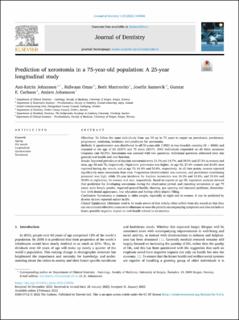| dc.description.abstract | Objectives
To follow the same individuals from age 50 up to 75 years to report on prevalence, persistence, progression, remission, incidence and predictors for xerostomia.
Methods
A questionnaire was distributed to all 50-years-olds (1992) in two Swedish counties (N = 8888) and repeated at the age of 65 (2007) and 75 years (2017). 3060 individuals responded on all three occasions (response rate 42.5%). Xerostomia was assessed with two questions. Additional questions addressed inter alia general/oral health and oral function.
Results
Reported prevalence of daytime xerostomia were 23.3% and 14.7%, and 39.5% and 27.5% in women and men, age 50 and 75, respectively. Night-time prevalence was higher. At age 50, 27.4% women and 24.0% men reported having dry mouth, and at age 75, 61.0% and 53.8%, respectively. At all time points, women reported significantly more xerostomia than men. Progression (deterioration) was common, and persistence (continuing presence) was high, while 25-year incidence for daytime xerostomia was 16.2% and 12.8%, and 33.6% and 29.8% at night-time, for women and men, respectively. Based on reports at age 50, regression analyses showed that prediction for developing xerostomia during the observation period, and reporting xerostomia at age 75 years, were female gender, impaired general health, chewing, jaw opening and intraoral problems, dissatisfaction with dental appearance, low education and having white/plastic filling.
Conclusions
Xerostomia is common in older people, especially at night and in women. It can be predicted by diverse factors reported earlier in life.
Clinical Significance
Clinicians need to be made aware of that elderly often suffers from dry mouth so that they can recommend effective measures to eliminate or ease the patients accompanying symptoms and also exclude or lessen possible negative impact on oral health related to xerostomia. | en_US |

